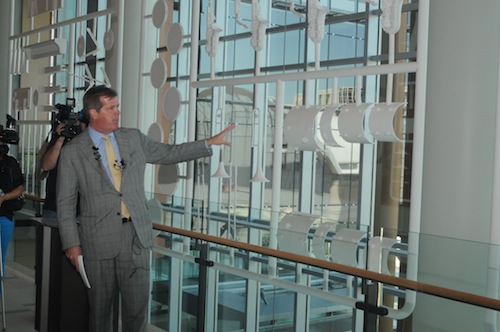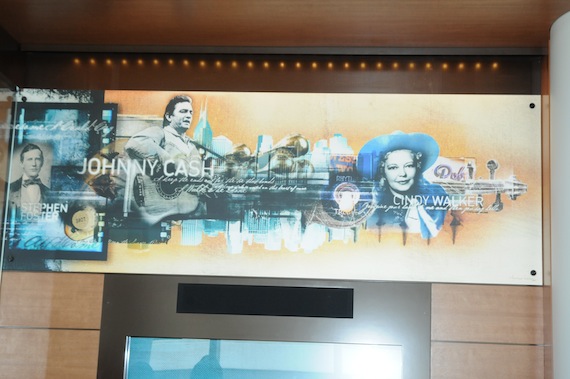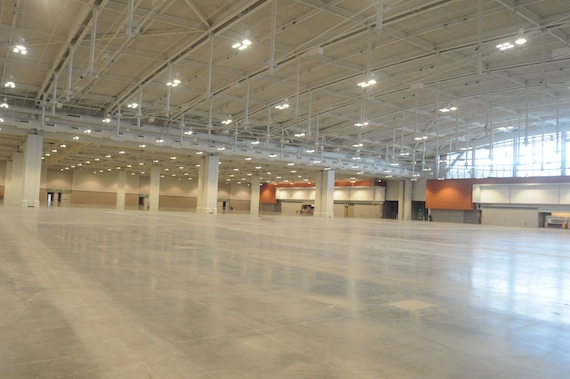
[slide]
All photos by Alan Mayor.
The Music City Center will be true to its name during its grand opening celebration during the next few days.
Music plans are plentiful. The Nashville Songwriters Hall of Fame will present members Bill Anderson, Sonny Curtis, Bobby Braddock, Pat Alger, Don Schlitz, Thom Schuyler and Rory Bourke singing their award-winning songs on Sunday (May 19) from 2:30 to 4:30 p.m. They’re saluting the opening of the organization’s exhibit gallery within the Music City Center.

Mayor Dean leads the media preview.
At 3 p.m., The Nashville Symphony Orchestra will be performing upstairs in the Grand Ballroom. Outside on the East Plaza, Phil Vassar and the pop/rock bands from the Ten Out of Tenn collective will also be performing on that afternoon, 2:30 to 6 p.m.
On Monday evening (May 20), Sheryl Crow, The Fisk Jubilee Singers, Mikky Ekko and The Time Jumpers will headline a multi-genre celebration, 6 p.m. to 9 p.m., followed by a fireworks display. All of these events are free, as are tours of the massive, futuristic structure on both days.
Walking shoes are recommended. At yesterday’s media preview (May 15), Mayor Karl Dean led reporters and TV crews on a two-hour hike through the five levels and six city blocks of the 2.1 million-square-foot Music City Center. And that did not include visits to all of the facility’s many features.
“Please try to keep up with our Fitness Mayor,” suggested his press secretary Bonna Delacruz Johnson. Accompanying the media preview tour were such key Music City Center figures as Charles Starks, Marty Dickens, Seab Tuck, Larry Atema, Rich Boyd and the facility’s director of marketing and public relations, J. Holly McCall.
The tour began at the Sixth Avenue & Demonbreun entrance. Sixth Avenue now runs beneath the Music City Center, dividing the building from its 1,800-space parking garage on the street level. Just inside this entrance is the Nashville Songwriters Hall of Fame gallery.
“Members will be performing during our opening,” Dean noted. He also pointed out the stone steps leading to the Fifth Avenue & Demonbreun entrance of the building. Each step is engraved with the name of a member, plus a representative song title and induction year. At the foot of the steps is Songwriters Square, located at the two streets’ intersection. Walking up these steps is the optimal way to enter the gallery.
Dean demonstrated the gallery’s interactive touch screens by selecting Bill Anderson and playing “Still,” then Joe Allison’s “I’d Fight the World.” Some of the panels also play video footage of the songwriters performing. Adjacent display cases house a variety of artifacts.
 Outside, next to Songwriters Square and running along Fifth, is a plaza outside the Music City Center where bands can play and festivals can be staged. This is directly opposite from the 800-room Omni Hotel now under construction. The hotel will be connected to the new exhibit space also under construction at the Country Music Hall of Fame.
Outside, next to Songwriters Square and running along Fifth, is a plaza outside the Music City Center where bands can play and festivals can be staged. This is directly opposite from the 800-room Omni Hotel now under construction. The hotel will be connected to the new exhibit space also under construction at the Country Music Hall of Fame.
Inside, Mayor Dean’s tour continued up an escalator to an open area the construction workers dubbed “The Whale.” This Grand Lobby is where the Mayor will deliver his State of Metro speech at 10 a.m. on Monday.
“There are no square angles in this room,” he pointed out. “It’s a unique feature of this center.” Indeed, the entire building undulates architecturally, from top to bottom.
Also: “We have the ability to put music everywhere in this building.” As we walked to the main convention exhibit hall, Nashville hits could be heard over the excellent sound system. Dean pointed out that the hallways’ carpeting is patterned with images of sound waves.
The exhibit hall is the size of an aircraft carrier, covering eight acres, 350,000 square feet. “You could put four 747s in here and still have 50 feet left over,” said Dean. On the Korean Veterans Blvd. side of the building are ramps leading to 32 load-in docks. The hall’s concrete floors are five feet thick, allowing semi-trucks to drive into it, if needed. The trusses weigh a million pounds each. Some 300 automobiles could be suspended from the hall’s ceiling.
Electric panels are scattered on the gigantic floor space, so that each exhibit booth can be easily powered. Overlooking the exhibit area are four offices and conference rooms.
The Music City Center contains 101 art pieces, collectively valued at $2 million. Eight of them are large works built on site, and several have music themes. “Composition,” for instance, is a 51-foot wide, 19.5-foot high, suspended installation weighing 400 pounds. It is a “floating orchestra” containing white castings of trombones, saxophones, fiddles, guitars, keyboards, drums, French horns, trumpets and basses. Of the 52 visual artists represented in the building’s collection, 48 are Tennesseans and 32 are from Nashville.
Tour attendees ascended two long escalators which revealed how much glass the Music City Center contains. The building is flooded with natural light throughout and offers dozens of views of downtown. There are also seven covered outdoor balcony patios with views.
As the tour entered the cathedral-like Grand Ballroom, two massive, 5,000-pound, wooden accordion doors slowly opened to reveal a stage containing the a cappella vocal quartet Lunch Break. The group serenaded the ballroom viewers with a barbershop arrangement of Elvis Presley’s “Good Luck Charm,” the first music performed in the Music City Center.
“This is the room with the ‘wow’ factor,” said Dean. “It is 57,500 square feet and can hold 6,000 people, the largest ballroom in the state of Tennessee. You feel like you are inside a guitar when you are here.” The Grand Ballroom is encased in wood panels on all sides, including the ceiling. Despite its immense size, it contains no columns.
The next stop was the Green Roof. This will not be accessible to the public, but can be seen from from nearby skyscrapers, the air or the Interstate. Designed to mimic the rolling hills of Middle Tennessee, it covers four acres, has 14 types of vegetation and will trap 360,000 gallons of water. This will be stored in an underground cistern and used for the toilets and landscape irrigation. The roof also holds 845 solar panels which help power the building.
Entering the jumbo, gleaming, white-and-silver kitchen, the tour goers were greeted by chef Max Knoepfel and sous chefs Richard Simms and Roger Keenan. Knoepfel, who hails from Switzerland, comes to Music City by way of New York.
“I came here for the opportunity to become friends and partners with the Nashville restaurant community,” he said. “We will be showcasing the food of Tennessee wherever possible,” as well as using local vendors and organic products.
 Media personalities such as Blake Farmer, John Dwyer, Meryl Rose, Kate Richardson, Aundrea Cline-Thomas and Alan Mayor sampled the kitchen’s cookies, examined the displayed entrees and desserts, sipped from water bottles and watched the staff fry 1,500 pounds of ground beef to be used in chili. Off the kitchen is a carpeted dining room for client tastings.
Media personalities such as Blake Farmer, John Dwyer, Meryl Rose, Kate Richardson, Aundrea Cline-Thomas and Alan Mayor sampled the kitchen’s cookies, examined the displayed entrees and desserts, sipped from water bottles and watched the staff fry 1,500 pounds of ground beef to be used in chili. Off the kitchen is a carpeted dining room for client tastings.
The staff is capable of preparing 22,000 meals a day. The core menu has 290 items on it. On hand are 18,000 stackable chairs, a multitude of folding banquet tables and 46,000 pieces of stackable china dinnerware.
The next stop was “Euphony,” a three-story installation of 1,141 bead chains, ascending and descending. The artwork is 116 feet long, contains 28 miles of beaded material and changes colors depending on its lighting.
The tour descended down three escalators to a hallway art gallery overlooking the tree-lined plaza on Demonbreun. Down another flight of stairs was one of the Music City Center’s several furnished board rooms, complete with artwork.
Also on this level was the Davidson Ballroom, a 1,500-capacity, 18,000-square-foot, wood-paneled venue that can be subdivided into smaller spaces. Dean continued his tour down to Level 1 and another art-bedecked hallway.
“On this floor and on Level 2, there are 60 meeting rooms,” he said. “There is plenty of business opportunity in this building.”

Photo: Alan Mayor
Touring it is much like exploring a giant space ship, partly because of the Center’s unusual shape. “One of the things I was interested in was not seeing a box. This building is not that. It was important that it be something special. It makes a statement about our city. It’s the largest project we’ve ever done.
“People want to come to this city. You’ve got the Country Music Hall of Fame, the Symphony Center, the Bridgestone Arena, the honky-tonks of Broadway, the stadium, Cummins Station and the Frist all within blocks of here.
“This is the best convention center in the United States,” Mayor Dean concluded. “It is not the biggest, but it is the best. But then, I’m biased.”
One of the first events in the new Music City Center will be next month’s CMA Music Festival.

About the Author
Robert K. Oermann is a longtime contributor to MusicRow. He is a respected music critic, author and historian.View Author Profile


